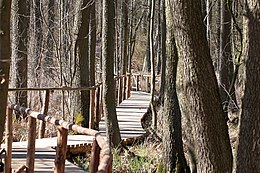Footbridge
A footbridge (by mhd. Stec ) is a relatively small and usually not very high bridge , which is mostly only used by pedestrians and cyclists to cross bodies of water or wetlands . There are bars in very different shapes and made of different materials (wood, stone, metal). Etymologically , the term, like Steig , Steige and Stiege, is related to the verb “to climb”, cf. "Climb up" and "climb over".
history
The remains of prehistoric boardwalks in moors have been preserved for thousands of years . The bars along the path can be supported by posts or they can also be placed on cross bars to form a grating that prevents them from sinking into the soft ground.
Jetty garden


Short bridges over ditches and small streams often only have their ends on the banks and are often not secured to the side. Longer bridges can be supported with posts or constructed as a suspension bridge ; lateral safeguards such as railings were often added later.
- The weir footbridge is a special form , in which a footbridge, mostly made of steel, crosses a weir . The Eiserne Steg and the Holbeinsteg over the Main in Frankfurt are particularly well-known .
- In contrast to other jetties, jetties and bathing jetties are not crossing structures to avoid bodies of water, but serve to better get to the water. Larger jetties are called piers .
- In the mountains, too, the term footbridge is used for paths that lead like a bridge over open terrain or water. It is used much less often for crates that are knocked out of the stone.
Stalks
In the Vier- und Marschlanden , paths are named Stegel , which lead from the dykes at a right angle away from the water. In earlier times, these paths were laid out as plank paths because of the damp marshland.
Makeshift bridges
In disaster control and technical assistance, for example, the THW uses various types of jetties as makeshift crossings to overcome obstacles or bodies of water. Traditionally, such makeshift bridges are made of wood with linen connections. A deployment scaffolding system is often used today. When the stone bridge in Regensburg was renewed from 2010 to 2015, a temporary walkway served as a replacement.
See also
Web links
Individual evidence
- ↑ Anita Wünschmann: The connection to nothing. There are footbridges in all variations: as a boat and ship landing stage, as a viewing platform, as part of traffic paths and as a means of expression in art. They connect and they separate people. In: Neues Deutschland from 29./30. July 2017, p. 22
- ↑ Civil Protection Service Regulation 280 of 1978
- ↑ Footbridge construction on the THW website, accessed on April 6, 2016
- ↑ Stone bridge soon without a temporary footbridge (idowa)
- ↑ Temporary footbridge will be removed after five years (BR)
